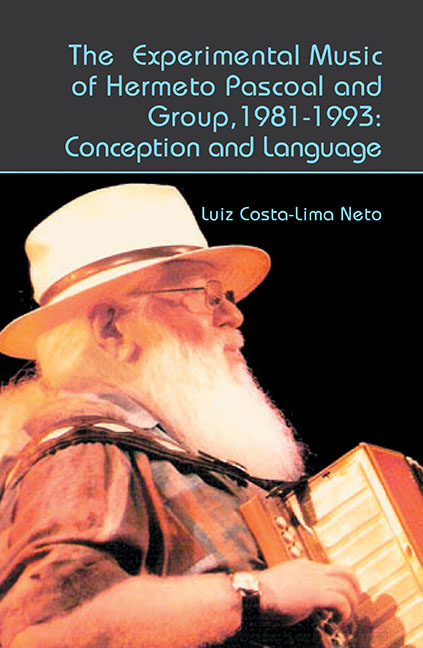Book contents
- Frontmatter
- Contents
- Miscellaneous Frontmatter
- Acknowledgments
- Introduction
- List of Illustrations
- Chapter 1 The conception and language of Hermeto Pascoal: first considerations
- Chapter 2 Bibliographic Discussion
- Chapter 3 The Creative Process Of Hermeto And Group
- Chapter 4 Reflections on Acoustics and Psycho-Acoustics
- Chapter 5 Selected Compositions For Analysis
- Conclusion
- Postscript
- Sources
- Plate section
Chapter 1 - The conception and language of Hermeto Pascoal: first considerations
- Frontmatter
- Contents
- Miscellaneous Frontmatter
- Acknowledgments
- Introduction
- List of Illustrations
- Chapter 1 The conception and language of Hermeto Pascoal: first considerations
- Chapter 2 Bibliographic Discussion
- Chapter 3 The Creative Process Of Hermeto And Group
- Chapter 4 Reflections on Acoustics and Psycho-Acoustics
- Chapter 5 Selected Compositions For Analysis
- Conclusion
- Postscript
- Sources
- Plate section
Summary
In a position that defies limiting labels and boundaries, Hermeto Pascoal's language places him between popular and erudite music. Sometimes he is too innovative according to the formulaic parameters of popular music; sometimes he is too popular according to the structural parameters of classical music. Thus, Hermeto Pascoal's experimental project is unique.
(…) I can't say what type of music I make. I make music, that's all. I play an infinity of rhythms, of sounds, of harmonies, of types, of styles … I adore playing “classical” music (I label it because that's what people like. I hate that) and suddenly I change to a carnival frevo from Recife or a baião from the Northeast.
(Hermeto, Jazz Magazine, 1984)Hermeto is, in fact, the creator of a very personal language, in which the dissonant harmonies of jazz are merged with popular rhythms and melodies, often from the Brazilian Northeast, the region where he was born in 1936. Nevertheless, his language is multidirectional, also containing elements that are common to contemporary erudite music, such as polychords, polyrhythms, the non-conventional use of conventional instruments and the exploration of noise and new possibilities of timbre through a varied arsenal of percussion, comprising the most various sound-producing objects.
Improvisation is another important feature of Hermeto Pascoal's music. The influence of American jazz is undeniable, although the improvisation practiced by Hermeto is not limited (as usually happens in traditional jazz) to the capacity for melodic reinvention based on only one harmonic structure. He can, for example, (as in “Magimani Sagei”), superimpose drum and bass ostinati, dogs barking, someone saying disconnected words, and consider all this as the “harmonic basis” on which several flutes will improvise freely, and at the same time merge their timbres with the dogs’ barks and the onomatopoeias and grunting voices through frullati, glissandi and other resources, such as singing inside the flutes as the notes are emitted. The exploration of sound used by Hermeto transcends the improvisational model of traditional jazz, bearing a greater resemblance to the experimentation that occurred in American free jazz in the 1960s.
- Type
- Chapter
- Information
- The Experimental Music of Hermeto Pascoal and Group, 1981–1993Conception and Language, pp. 1 - 12Publisher: Boydell & BrewerPrint publication year: 2015



